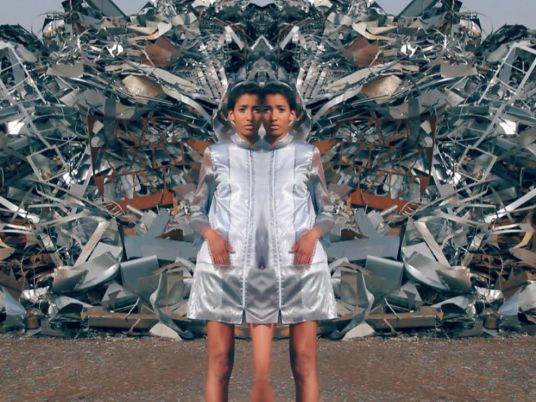In our contemporary societies, paper, when not neglected, is mostly considered simply as a base for the more valuable things that are written, printed, or painted on it. Very few people see it as a work of art in itself, taking care over individual fibers to preserve the medium’s whole identity and its natural beauty.
Japanese and Egyptian artists Kyoko Ibe and Mohamed Abouelnaga are currently showcasing their paper artworks in a joint exhibition titled “Paper Tales” which is being held at Darb 17 18 gallery in old Cairo.
“I don’t make paper […] I make art pieces,” says Ibe, dressed in a traditional Japanese gown with a broad scarf falling over her shoulder. Ibe started using wood fiber for artistic purposes at a time when it was solely used for traditional Japanese arts and crafts. “Japan has a very long tradition of paper-making and a vast knowledge of how to treat the fiber in the best possible way,” the artist continues. She points at the art piece close to her, indicating the dual aspect of the paper-made board.
Ibe, taking the wood fiber, or “kozo,” to another level of appreciation, invented from scratch the system that enables her to achieve her innovative works of art. “I knew all along that it was possible to create something beautiful by mixing only kozo and natural water on a bamboo canvas,” explains the artist, who details the various steps of the artistic process. Finely-cut kozo is put into a solution of water and natural mineral pigments and left to dry on a bamboo canvas, before being delicately removed.
Slightly brushing the tip of a fiber that extends from the art piece, Ibe says that “this technique enables me to disperse the fiber without losing any of the details.” All of the works that are exhibited are her latest and most of them present an interesting mix of textures.
A semicircle repeats its appearance in Ibe’s work, streaked with bamboo prints and long, fluffy fibers, with the rest of the board being flat. “I used the paper of old documents to fashion the flat, upper part of the piece,” she says, explaining that paper recycling began in Japan in AD996, only 200 years after the introduction of paper to the country. “Everybody claims that recycling is a modern concept, when it’s been going on for so many centuries!” she says. “The rest is kozo fiber,” she continues, pointing at the stream of light, crimson studded with silver scales, that runs along the piece against a golden background.
A few steps further, the artist shows me an impressive installation in pure white polyester that is “washable and fire-proof.” The beautifully folded paper creation tumbles down from the ceiling with extraordinary lightness. Artist Ibe has created numerous impressive pieces like this one, that have been used to decorate theater and dance stages, as well as chic malls all over the world.
A series of stitched paper curtains in shades of white, beige, grey and black grabs everyone’s attention, and the gallery’s visitors enter into this paper-woven universe with pleasure.
Egyptian visual artist Mohamed Abouelnaga met Kyoko Ibe ten years ago. “She was my supervisor in Japan for six months,” explains Abouelnaga. Indeed, he was first Middle-Eastern artist ever to receive a grant from the Japan Foundation to study the art of paper-making.
“I went to Japan in 1996, and it was a wonderful experience,” says the artist, who uses papers of different origins in his artwork in order to blend many cultures and civilizations within his art. “I discovered that paper-making is a very slow process to achieve a very high-quality paper, and kozo fiber is extraordinary to work with,” he adds.
The pieces exhibited in Darb 17 18 are mixed media pieces which blend photography, painting, collage, fiber and linen paper on various layers. “I photographed many shop windows during my travels for this “Vetrina” exhibition, because they are a clear reflection of a society and have political implications,” Abouelnaga says.
At least three pieces reuse the same object: an abandoned plastic white mannequin that lies on a bed, but viewed from various angles. The loneliness of this white, glossy object is reinforced by the extra-thin, fibrous layer of paper applied to the art piece.
The artist also uses folded papyrus leaves in his work, a collage of old documents in Arabic, and half-torn photographs taken at the souq in Sayeda Zeinab. By blending extreme-oriental and oriental influences in his work the artist has given his work an international flair.
Kyoko Ibe and Mohamed Abouelnaga’s works are to be discovered at Darb 17 18 from now until 27 February, every day except Thursdays,from 10 AM to 10 PM (from 2 PM to 10 PM on Fridays).
[email protected]
www.darb1718.com
+2 02 2361 0511




